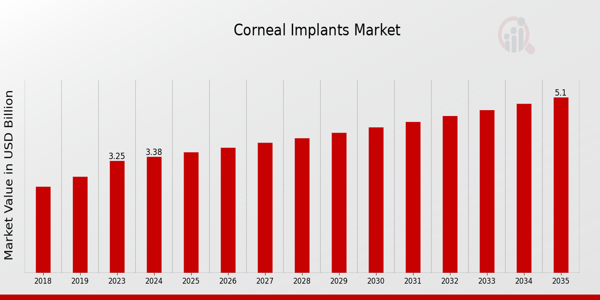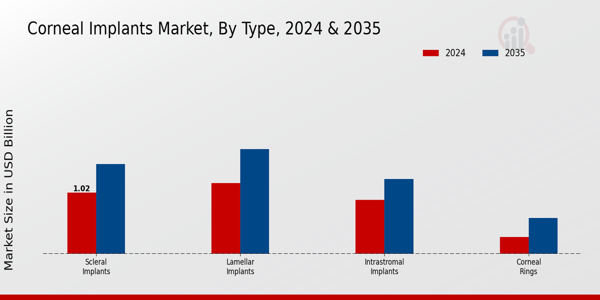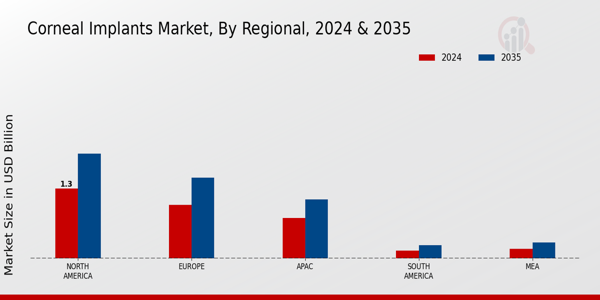Corneal Implants Market Overview
As per MRFR analysis, the Corneal Implants Market Size was estimated at 3.25 (USD Billion) in 2023. The Corneal Implants Market is expected to grow from 3.38 (USD Billion) in 2024 to 5.1 (USD Billion) by 2035. The Corneal Implants Market CAGR (growth rate) is expected to be around 3.82% during the forecast period (2025 - 2035).
Key Corneal Implants Market Trends Highlighted
Growing rates of eye-related conditions, an aging population, and improvements in medical technology are all contributing to the substantial expansion of the global corneal implants market. The demand for novel corneal implant solutions is being driven by the need for efficient treatments for diseases including keratoconus and corneal scarring.
The market is also expanding as a result of increased awareness of visual impairment and an increase in eye procedures. New designs and materials for corneal implants have made it easier for medical professionals to meet each patient's specific demands. Stakeholders can take advantage of a variety of chances in this sector.
As technology advances, there is potential for the development of customized corneal implants that can cater to individual patient requirements. Emerging markets, particularly in developing regions, present untapped potential for growth as more people seek access to advanced eye care solutions.
Collaborations between research institutions and manufacturers can lead to further innovations, enhancing patient outcomes and expanding market reach. Furthermore, as telehealth continues to gain traction, integration of remote consultations and monitoring tools may open channels for effective patient management, thus boosting service accessibility and effectiveness.
Recent trends indicate a shift towards minimally invasive surgical techniques and biocompatible materials for corneal implants. The increasing focus on patient-centric care is leading to personalized treatment plans, enhancing patient satisfaction and adherence.
Digital health initiatives and artificial intelligence are shaping the future of eye care, allowing for early diagnosis and better management of conditions that necessitate corneal implants.
As the market continues to evolve, companies are adapting their strategies to encompass holistic approaches that prioritize both technological advancements and improved patient experiences. With these developments, the corneal implant market is set to thrive in the coming years, driven by innovation, unmet needs, and a commitment to better eye health.

Source: Primary Research, Secondary Research, MRFR Database and Analyst Review
Corneal Implants Market Drivers
Increasing Incidence of Eye Disorders
The Global Corneal Implants Market is primarily driven by the rising prevalence of eye disorders such as keratoconus, Fuchs' dystrophy, and corneal scarring. These conditions often lead to vision impairment and discomfort, necessitating the use of corneal implants as a treatment option.
The growing awareness of eye health and the increasing prevalence of these disorders, particularly in aging populations, are significant factors for market growth. As people live longer, they become more susceptible to age-related eye conditions, further amplifying the demand for corneal implants.
Additionally, advancements in diagnostic technologies and improved access to healthcare services contribute to early detection and treatment, enhancing the overall market potential. As the healthcare landscape evolves and patient education increases, more individuals seek treatment for their conditions, propelling the growth of the Global Corneal Implants Market.
Eye care professionals are also urging patients to undergo surgical interventions more frequently, which underscores the importance of corneal implants as a viable solution. The focus on addressing eye disorders is likely to further enhance the sales and adoption rates of corneal implants.
Technological Advancements in Implant Design
Technological advancements in the design and materials of corneal implants are significantly driving the Global Corneal Implants Market. Innovations such as bioengineered corneal implants, which closely mimic natural corneal structures, are improving surgical outcomes and patient satisfaction.
These advancements facilitate better integration with the eye and enhance the overall success rates of corneal procedures. The use of femtosecond lasers and other cutting-edge surgical tools improves the precision of implant placement, ultimately leading to quicker recovery times and better visual acuity for patients.
Rising Awareness and Accessibility of Eye Care
There is a growing emphasis on raising awareness about eye health and the available treatments for vision-related issues in the Global Corneal Implants Market. Initiatives to promote eye care are leading to a greater understanding of the importance of timely intervention for eye disorders.
Increased accessibility to advanced healthcare facilities and eye care specialists further fuels the demand for corneal implants. As more individuals seek preventative care and treatment options, the market is expected to experience steady growth as awareness translates into higher adoption rates.
Corneal Implants Market Segment Insights
Corneal Implants Market Type Insights
The Global Corneal Implants Market showcased significant growth with a variety of types, each serving specific needs in ophthalmology.
In 2024, the Scleral Implants segment was valued at 1.02 USD Billion, illustrating a major role in the market due to its application in treating severe corneal ectasia and disorders. By 2035, this segment is projected to reach 1.5 USD Billion, indicating its majority holding is driven by a rising prevalence of such conditions and the increasing need for effective surgical interventions.
Lamellar Implants reached 1.18 USD Billion in 2024 and are likely to climb to 1.75 USD Billion by 2035, contributing significantly to the Global Corneal Implants Market because of their use in corneal transplantation procedures that preserve more corneal tissue, which was vital in enhancing recovery outcomes for patients.
Intrastromal Implants presented a strong growth trajectory, too, starting at 0.9 USD Billion in 2024 and reaching 1.25 USD Billion in 2035. This growth was driven by innovations in refractive surgery and the increasing demand for vision correction options among patients.
Furthermore, Corneal Rings, while the smallest segment with a valuation of 0.28 USD Billion in 2024, climbing to 0.6 USD Billion by 2035, served a unique role in assisting patients with keratoconus and irregular corneas. Despite having a lesser valuation, this segment played a crucial role in expanding the treatment options available for corneal irregularities.
The overall dynamics of the Global Corneal Implants Market segmentation highlighted not just the varying valuations among these types, but also the evolving technologies and growing patient populations demanding advanced corneal treatments across the board.
This segmented analysis offered insights into market growth potential and the specific drivers associated with each type's significance in the marketplace.

Source: Primary Research, Secondary Research, MRFR Database and Analyst Review
Corneal Implants Market Material Insights
The Global Corneal Implants Market revenue reflects a steadily growing industry primarily driven by advances in materials used for implants. Hydrogel materials are gaining traction due to their high water content and biocompatibility, which enhances patient comfort. PMMA has traditionally dominated the market owing to its robustness and optical clarity, making it a preferred choice in many procedures.
Silicone offers flexibility and resilience, catering to patients with varying needs. Meanwhile, Biodegradable Polymers are emerging as a promising alternative, appealing to the growing demand for sustainable and safe medical solutions.
The Global Corneal Implants Market segmentation highlights the importance of these materials, as they not only contribute to improved patient outcomes but also drive innovation within the industry.
Market growth is further supported by rising awareness about corneal diseases and advances in implant technology, though challenges such as regulatory hurdles and varying adoption rates could impact future trajectories. Understanding these dynamics is crucial for stakeholders aiming to leverage the opportunities within the Global Corneal Implants Market Data and Statistics.
Corneal Implants Market Application Insights
The market segment includes various applications such as Refractive Surgery, Corneal Transplantation, Trauma Repair, and Keratoconus Treatment, each playing a vital role in improving ocular health.
Refractive Surgery is significant as it addresses common vision issues, while Corneal Transplantation remains a crucial option for patients with severe corneal damage or disease, ensuring a majority holding in the market.
Trauma Repair is essential for restoring vision and eye function post-injury, and Keratoconus Treatment is gaining importance due to its increasing prevalence. As the Global Corneal Implants Market data indicates, these applications are supported by technological advancements and an aging population, driving the demand for corrective and restorative eye procedures.
Market Statistics highlight the growing focus on improving surgical outcomes and patient experiences, presenting opportunities for innovation and investment in the industry. However, challenges such as regulatory hurdles and the need for specialized training pose risks that could impact market growth.
Corneal Implants Market End Use Insights
The Global Corneal Implants Market has shown significant growth within the End Use segment, where hospitals, ophthalmic clinics, and ambulatory surgical centers play pivotal roles. Hospitals dominate this market segment, providing comprehensive treatment facilities that cater to various corneal issues, thereby holding a substantial share due to their extensive resources and specialized staff.
Ophthalmic clinics are also significant as they offer focused eye care services, enhancing patient access to targeted treatments. The ambulatory surgical centers further contribute to this segment by providing a more streamlined and cost-effective approach to surgery, facilitating quicker patient recovery times.
The synergy among these facilities addresses the growing need for corneal implants, highlighting both the challenges in surgical complexities and the opportunities for advanced medical technologies, all contributing to a positive outlook on the Global Corneal Implants Market in the coming years.
Corneal Implants Market Regional Insights
The Global Corneal Implants Market showed a diverse regional landscape, with North America holding the majority share, valued at 1.3 USD Billion in 2024 and projected to grow to 1.95 USD Billion by 2035. This dominance stemmed from advanced healthcare infrastructure and significant investment in research and development.
Europe followed closely, with a valuation of 1.0 USD Billion in 2024, highlighting its robust adoption of innovative eye care solutions, expected to reach 1.5 USD Billion by 2035. In the Asia-Pacific (APAC) region, the market was valued at 0.75 USD Billion in 2024 and is anticipated to grow to 1.1 USD Billion by 2035, driven by increasing healthcare access and an aging population.
South America, while smaller with a market valuation of 0.15 USD Billion in 2024, is expected to see gradual growth to 0.25 USD Billion by 2035, showcasing a developing healthcare system. The Middle East and Africa (MEA) also played a minor yet crucial role, valued at 0.18 USD Billion in 2024, projected to rise to 0.3 USD Billion by 2035, balancing progress with varying economic conditions.
Overall, the Global Corneal Implants Market segmentation illustrated significant growth opportunities across these regions, each contributing to advancements in eye health and technological integration within the industry.

Source: Primary Research, Secondary Research, MRFR Database and Analyst Review
Corneal Implants Market Key Players and Competitive Insights:
The Global Corneal Implants Market has seen significant growth over recent years due to advancements in technology, increased awareness of eye health, and a growing aging population prone to eye disorders. This competitive landscape is characterized by a mix of established players and emerging companies leveraging innovative solutions to enhance patient outcomes.
The presence of key market participants focusing on research and development, along with strategic collaborations and partnerships, has amplified the competition. Companies are prioritizing product differentiation and enhancing their distribution networks to gain a competitive edge in various regional markets.
Trends such as the integration of cutting-edge materials and surgical techniques are also shaping the dynamics of the market, thereby creating opportunities and challenges for existing and new entrants.
KeraLink International has established a remarkable presence within the Global Corneal Implants Market by specializing in providing high-quality corneal tissue for transplantation. Earning a reputation for excellence, KeraLink International channels its expertise into innovative approaches towards corneal health.
The company's commitment to quality assurance and effective procedures positions it as a trusted supplier for various healthcare institutions.
By emphasizing the importance of patient care and the efficacy of its corneal implants, KeraLink International has built strong relationships with medical professionals, which augments its credibility and market strength. Its operational efficiency and a focus on advanced preservation techniques also contribute significantly to its success in the competitive landscape.
Abbott Laboratories is another noteworthy player in the Global Corneal Implants Market, known for its comprehensive healthcare solutions. Specifically within this segment, Abbott Laboratories leverages its vast experience in biotechnology and medical devices to develop innovative corneal implant technologies that significantly improve surgical outcomes.
The company's strong research and development wing allows for the continual enhancement of its product offerings, ensuring they meet the evolving needs of both patients and surgeons. Abbott's global reach and established brand reputation lend additional strength to its market proposition, facilitating collaborations and broadening access to its corneal implants.
Through a commitment to innovation, quality, and effective healthcare solutions, Abbott Laboratories is poised to enhance its standing within the competitive landscape of corneal implants.
Key Companies in the Corneal Implants Market Include:
- KeraLink International
- Abbott Laboratories
- Johnson and Johnson
- EyeYon Medical
- TheraPearl
- Carl Zeiss AG
- Enovis
- Medivis
- Ocular Therapeutix
- Avedro
- Santen Pharmaceutical
- Bausch Health Companies
- Alcon
- SightLife
- AccuLens
Corneal Implants Market Developments
The Global Corneal Implants Market has recently witnessed significant developments, particularly with advancements in technology and product innovation from companies like KeraLink International and Johnson Johnson. EyeYon Medical has been gaining traction with its innovative corneal devices designed to enhance visual outcomes while Abbott Laboratories continues to expand its product range.
Bausch Health Companies has also highlighted its commitment to advancing corneal implant solutions. Furthermore, Santen Pharmaceutical has reported growth in its market valuation, positively impacting overall market dynamics.
In terms of mergers and acquisitions, Alcon announced a strategic partnership with SightLife focused on expanding access to corneal transplants, which was publicly confirmed. There remains a focus on creating synergy among market players as companies like Carl Zeiss AG and Ocular Therapeutix explore collaborative opportunities to enhance product offerings and market reach.
The overall growth in market valuation has led to increased investments and intensified competition, shaping the strategic decisions of companies, including TheraPearl, Enovis, and AccuLens, within the Global Corneal Implants Market.
Corneal Implants Market Segmentation Insights
Corneal Implants Market Type Outlook
- Scleral Implants
- Lamellar Implants
- Intrastromal Implants
- Corneal Rings
Corneal Implants Market Material Outlook
- Hydrogel
- PMMA
- Silicone
- Biodegradable Polymers
Corneal Implants Market Application Outlook
- Refractive Surgery
- Corneal Transplantation
- Trauma Repair
- Keratoconus Treatment
Corneal Implants Market End Use Outlook
- Hospitals
- Ophthalmic Clinics
- Ambulatory Surgical Centers
Corneal Implants Market Regional Outlook
- North America
- Europe
- South America
- Asia Pacific
- Middle East and Africa
| Attribute/Metric Source: |
Details |
| MARKET SIZE 2023 |
3.25(USD Billion) |
| MARKET SIZE 2024 |
3.38(USD Billion) |
| MARKET SIZE 2035 |
5.1(USD Billion) |
| COMPOUND ANNUAL GROWTH RATE (CAGR) |
3.82% (2025 - 2035) |
| REPORT COVERAGE |
Revenue Forecast, Competitive Landscape, Growth Factors, and Trends |
| BASE YEAR |
2024 |
| MARKET FORECAST PERIOD |
2025 - 2035 |
| HISTORICAL DATA |
2019 - 2024 |
| MARKET FORECAST UNITS |
USD Billion |
| KEY COMPANIES PROFILED |
KeraLink International, Abbott Laboratories, Johnson and Johnson, EyeYon Medical, TheraPearl, Carl Zeiss AG, Enovis, Medivis, Ocular Therapeutix, Avedro, Santen Pharmaceutical, Bausch Health Companies, Alcon, SightLife, AccuLens |
| SEGMENTS COVERED |
Type, Material, Application, End Use, Regional |
| KEY MARKET OPPORTUNITIES |
Increasing prevalence of corneal diseases, Advancements in implant technology, Growing geriatric population, Rising awareness of eye health, Expanding healthcare reimbursement policies |
| KEY MARKET DYNAMICS |
Increasing prevalence of eye diseases, Advancements in surgical techniques, Growing geriatric population, Rising adoption of minimally invasive procedures, Expanding healthcare infrastructure |
| COUNTRIES COVERED |
North America, Europe, APAC, South America, MEA |
Frequently Asked Questions (FAQ) :
The Global Corneal Implants Market is expected to be valued at 3.38 USD Billion in 2024.
By 2035, the Global Corneal Implants Market is projected to reach a value of 5.1 USD Billion.
The anticipated CAGR for the Global Corneal Implants Market from 2025 to 2035 is 3.82%.
North America is expected to hold the largest market share, valued at 1.3 USD Billion in 2024.
The European segment is forecasted to be valued at 1.5 USD Billion in 2035.
Lamellar implants are expected to have a market value of 1.75 USD Billion in 2035.
Major players include KeraLink International, Abbott Laboratories, and Johnson and Johnson, among others.
The APAC region is anticipated to grow from a market value of 0.75 USD Billion in 2024 to 1.1 USD Billion by 2035.
Scleral implants are valued at 1.02 USD Billion in 2024 and are expected to reach 1.5 USD Billion by 2035.
Corneal rings are projected to have a market value of 0.28 USD Billion in 2024.
















